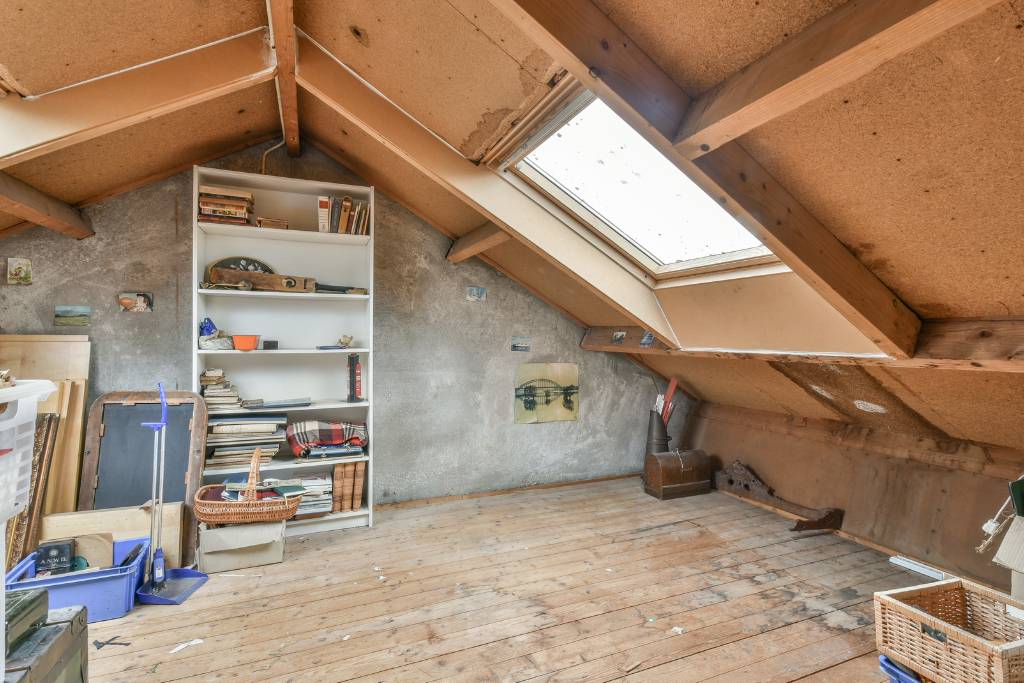Adopting a compact home lifestyle can provide homeowners with financial benefits and lower maintenance requirements. These homes often come with reduced initial purchase prices, energy costs, and property taxes, enabling residents to allocate funds towards experiences instead of material items. The smaller living area also means spending less time and effort on cleaning and general upkeep. However, one might face challenges due to the smaller space and limited storage. Adjusting to a simpler lifestyle and finding innovative ways to stay organized are essential. Techniques like using furniture that serves multiple purposes, maximizing vertical storage, and routinely decluttering can effectively utilize the available space. By applying these strategies, homeowners can enjoy the economic and maintenance advantages of a compact home, ensuring a cozy, well-arranged, and enjoyable living environment.
Importance of utilizing attic space
Utilizing attic space is important for maximizing the square footage of a home and increasing its resale value. Converting the attic into a new room or using it for storage can add significant value to a property. Additionally, creating a living space in the attic can provide better air circulation throughout the home, leading to improved indoor air quality and energy efficiency.
Careful planning and legal compliance are crucial when repurposing attic space. Building codes and regulations must be followed to ensure the safety and structural integrity of the home. In some cases, replacing trusses in the attic may be necessary to create additional living space, which requires professional assessment and construction.
By utilizing attic space effectively, homeowners can not only benefit from additional functionality and comfort in their home, but also potentially increase its resale value. Whether it’s for creating a new living area, providing additional storage, or promoting better air circulation, the attic holds significant potential for enhancing the overall quality and value of a home.
Benefits of finishing the attic
Finishing the attic is a popular home improvement project that offers a range of benefits for homeowners. From adding valuable living space to enhancing the overall property value, converting an attic into a usable area can have a significant impact on a home. Additionally, finishing the attic allows for more efficient use of the existing space, providing an opportunity for creating an extra bedroom, a home office, or even a storage area. This can be particularly advantageous for growing families or those who work from home. Moreover, a finished attic can also improve the insulation and energy efficiency of the home, resulting in potential savings on utility bills. In addition, the aesthetic appeal of a beautifully finished attic can enhance the overall appeal and comfort of the home. With so many advantages to offer, finishing the attic is a worthwhile investment for homeowners looking to maximize the potential of their property.

Assessing Feasibility and Building Code Requirements
Assessing the feasibility and building code requirements for a specific project involves several key steps. First, it is essential to thoroughly understand the project parameters, including the intended use of the building, the size, and the overall scope of the project. Next, research on the specific location where the project will take place is necessary to understand the local regulations and zoning requirements. This may involve consulting with local planning departments or hiring a professional familiar with the area’s building codes.
Once the project parameters and local regulations are understood, it is important to analyze the building code requirements that are specific to the type of construction being planned. This may involve consulting with architects, engineers, or other building professionals to ensure that the project will meet all necessary safety and construction standards. Throughout this process, a feasibility assessment will need to be conducted to determine if the project is financially and practically viable based on the building code requirements and local regulations. This may involve cost analysis, risk assessment, and potential roadblocks related to the project parameters and location. By following these steps, the feasibility and building code requirements for a specific project can be thoroughly assessed and addressed.
Checking building code regulations for attic conversions
Before starting an attic conversion, it is essential to check the building code regulations to ensure that the space meets all safety and habitability requirements.
Building code regulations for attic conversions often include requirements for natural light, heating, ventilation, and emergency openings. Natural light may be required through the installation of windows, skylights, or other suitable means. Heating must be adequate for the space, often with a dedicated heating system or appropriate insulation. Ventilation is crucial for maintaining air quality and may be achieved through the installation of vents or fans. Additionally, emergency openings such as windows or doors are required for safe egress in the event of a fire or other emergency.
To ensure that your attic conversion meets all of these code requirements, it is important to consult with a professional contractor or architect who is knowledgeable about local building codes. They can assess the space and ensure that it meets all necessary regulations for natural light, heating, ventilation, and emergency openings. By following these regulations, you can create a safe and habitable living space in your attic.
Determining if the attic is suitable for finishing
When determining if an attic is suitable for finishing, several key considerations should be evaluated to ensure a successful and functional transformation of the space. First, the ceiling height should be sufficient to accommodate the desired use of the attic, whether it is for living space or storage. The structural integrity of the attic is also crucial, as it needs to be able to support the additional weight of finishing materials and furniture.
Access to the attic is another important factor, as there should be a safe and convenient way to enter and exit the space. Windows and ventilation are essential for natural light and air circulation, so the attic should have adequate openings for these purposes. Additionally, building codes and regulations should be carefully reviewed to ensure that the attic finishing project meets all necessary requirements for safety and compliance with local laws.
By considering these factors, homeowners can determine if their attic is suitable for finishing and can proceed with the transformation with confidence.
Consulting with a professional contractor or architect
When planning a construction or renovation project, it is essential to consult with a professional contractor or architect to ensure that your vision is brought to life in the most efficient and effective way. These experts have the knowledge and experience to navigate the complexities of building codes, zoning laws, structural requirements, and material selections. By seeking the guidance of a professional, you can save time, money, and avoid potential headaches down the road. Whether it’s a small home improvement project or a large commercial development, working with a skilled contractor or architect will help you achieve your goals with confidence and peace of mind.
Maximizing Natural Light in the Attic
Maximizing natural light in the attic can be achieved by installing skylights or dormer windows to increase the sunlight entering the space. These new openings will bring in more light and create a brighter and more inviting atmosphere. Additionally, using light-colored finishes and reflective materials on the walls and ceiling can help bounce the natural light around the attic. Strategically placing mirrors in the space can further amplify the natural light, making the attic feel even brighter and more spacious.
It is important to ensure that any new openings for windows or skylights are properly insulated and sealed to prevent heat loss in the attic. This will help maintain a comfortable temperature in the space and prevent energy wastage.
By incorporating skylights, dormer windows, light-colored finishes, reflective materials, and strategically placed mirrors, the attic can be transformed into a well-lit and functional space that maximizes natural light.

Evaluating existing windows and skylights
The existing windows in the room are in good condition, with no noticeable damage or deterioration. They are functional and effectively allow natural light to enter the space. However, the placement of the windows could be improved to maximize ventilation and enhance the overall aesthetic of the room.
As for the skylights, they are also in good condition and contribute to the natural lighting of the room. However, there are some concerns regarding potential leakage during heavy rain or snow. This issue needs to be addressed to prevent any water damage.
To improve the natural light and ventilation in the room, potential upgrades could include replacing the existing windows with larger, energy-efficient models that allow for better airflow. Additionally, installing additional skylights could further enhance the natural lighting in the space.
Overall, a thorough evaluation of the existing windows and skylights reveals their good condition and functionality, but there are opportunities for upgrades to improve the overall lighting and ventilation in the room.
Adding additional windows or skylights for more natural light
Maximizing natural light in your attic can significantly enhance the functionality and visual appeal of the space. By adding additional windows or skylights, you can bring in more sunlight, improving the overall atmosphere and potentially offering stunning views of the surrounding area.
To further enhance the functionality and energy efficiency of the space, consider incorporating remote-control operation for the windows or skylights, allowing for easy adjustment without the need to physically reach them. Additionally, including roll-up insect screens can help keep unwanted bugs out during the warmer months, while solar shades can help regulate the amount of sunlight and heat entering the attic.
Incorporating recessed LED fixtures can also offer additional lighting when natural light is limited, allowing for a well-lit and welcoming atmosphere throughout the day and into the evening.
Overall, by adding skylights, windows, and incorporating remote control operation, roll-up insect screens, solar shades, and recessed LED fixtures, you can transform your attic into a bright, functional, and energy-efficient space that offers beautiful views and ample natural light.
Choosing appropriate window treatments for privacy and insulation
Choosing appropriate window treatments for privacy and insulation is a critical decision when it comes to creating a comfortable and serene living space. Ensuring that your windows are properly covered not only provides privacy and control over natural light, but also helps to insulate your home, keeping it cool in the summer and warm in the winter. With a variety of options available, from curtains and drapes to blinds and shades, it’s important to consider factors such as the specific needs of each room, personal style, and energy efficiency. Selecting the right window treatments can help enhance the overall aesthetic of your home while also contributing to a more energy-efficient environment.
Optimizing Usable Space in the Attic
The attic is often an underutilized area in many homes, but with some creative thinking, it can become a valuable space for storage and organization. One way to maximize the usable space in the attic is to incorporate built-in storage solutions such as custom cabinets, drawers, and closets. These can be integrated into the eaves and angled ceilings to make the most of every inch of available space.
Installing shelving is another effective way to optimize the attic. Adjustable and floating shelves can be used to store items of various sizes and shapes, and they can be placed strategically along the walls to keep the floor area clear. Additionally, utilizing the vertical space by adding hanging racks, hooks, and wall-mounted organizers can help keep the attic organized and clutter-free.
To make the most of the available area, consider using multipurpose furniture such as storage ottomans, trunks, or benches with built-in compartments. These pieces can serve as seating while providing additional storage space for items that are not frequently accessed.
Lastly, getting creative with organization solutions such as clear storage bins, labeled containers, and modular systems can help maximize the functionality of the attic. With these strategies, the attic can be transformed into a practical and efficient storage area.
Considering the purpose of the finished attic (e.g., bedroom, office, playroom)
The intended purpose of the finished attic is to serve as a functional living space, such as a bedroom, office, playroom, or storage area. If the finished attic will be utilized as a living space, it is recommended to consider adding a bathroom during construction to increase the resale value of the property. It is essential to ensure that the finished attic meets all relevant code requirements for habitability, including heating, natural light, ventilation, and emergency openings. This may involve installing adequate insulation and ventilation, as well as ensuring that there are sufficient windows and emergency exits. By meeting these code requirements, the finished attic can be transformed into a comfortable and safe living space that adds value to the property.
Planning furniture layout and storage options to maximize space efficiency
When planning the furniture layout and storage options for an attic to maximize space efficiency, it is important to consider utilizing perimeter drawers, cabinets, and cubbies. These can help save valuable floor space by making use of the walls for storage. In addition, recessing furniture into knee walls can provide added storage without taking up valuable floor space.
When making any changes to the attic’s structure, such as replacing trusses with steel beams for better space utilization, it is essential to carefully plan and execute these changes. It is crucial to ensure that any alterations comply with building codes and maintain the roof’s structural integrity.
By carefully considering the layout and storage options in the attic, it is possible to make the most of the available space while maintaining a functional and stylish living area. Taking advantage of the perimeter and recessed storage options can help keep the attic organized and efficient, while ensuring that any structural changes are done safely and compliant with building codes.
Incorporating built-in shelves, cabinets, or closets for added functionality
One option for incorporating built-in shelves, cabinets, or closets in the attic-turned-walk-in closet is to install floor-to-ceiling built-in shelves along one or more walls. These shelves can be used to store shoes, folded clothes, accessories, and other items, maximizing the vertical space and keeping the floor area free for movement.
Another option is to include built-in cabinets underneath the slanted ceiling of the attic. These cabinets can be customized to fit the unique shape of the space and can be used to store bulky items, seasonal clothes, linens, and more. Additionally, incorporating built-in closets with hanging rods and additional shelving can provide a designated space for hanging clothes and keeping them organized.
Utilizing the existing unused space in the attic, such as the eaves and alcoves, for built-in storage solutions can also help maximize the functionality of the walk-in closet. This could include incorporating pull-out drawers, built-in hampers, or custom-built storage units to keep the space organized and clutter-free.
By strategically placing these built-in shelves, cabinets, and closets, the attic-turned-walk-in closet can be transformed into a highly functional and efficient storage area, making the most of the available space.

FAQ’S:
What are floor joists, and why are they important in attic renovations?
Floor joists are horizontal beams that provide structural support to the attic floor. They are necessary for creating a safe and sturdy finished space, ensuring the proper weight distribution and load-bearing capabilities.
How should I properly insulate my finished attic?
Proper insulation is crucial in a finished attic to maintain comfortable temperatures and energy efficiency. Two common types of attic insulation include batt insulation and blown-in insulation. Consult with a professional to determine the most suitable option for your attic.
Are there any specific requirements for light fixtures in a finished attic?
Safety should be a top priority when it comes to electrical fixtures in a finished attic. Ensure that all light fixtures are approved for use in ceilings and meet the necessary electrical code requirements.
How much space is needed to make an attic bedroom?
The livable space in an attic typically depends on the size and dimensions of the attic itself. However, it is generally recommended to have a minimum of around 7 feet wide to meet building and safety codes.
Can I use the attic for storage even if it is not finished?
Yes, an unfinished attic can still be used for storage purposes as long as it is safe to access and store items. However, take care not to overload the attic or place excessive weight on the floor joists, as it may compromise their integrity.
Needs help? Call Attic Crew Today for all of your attic needs!



